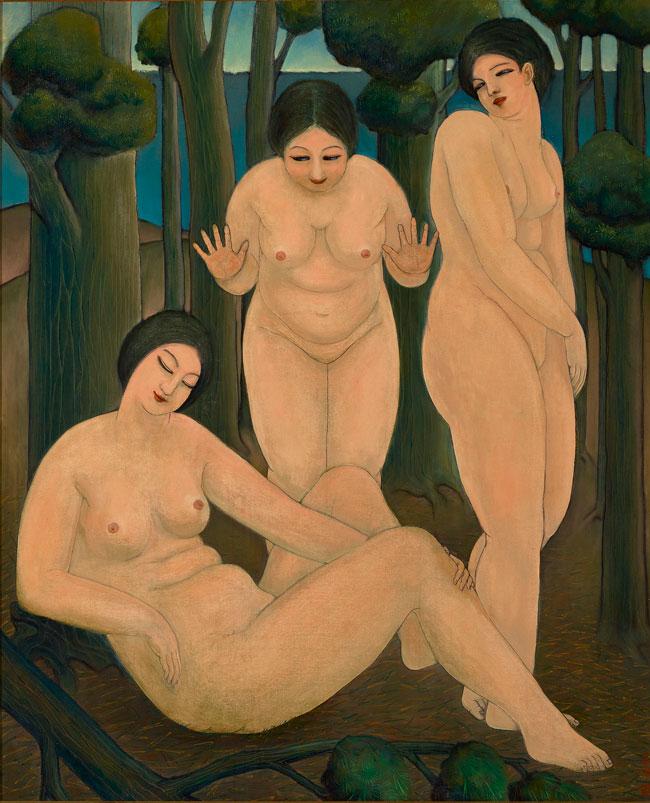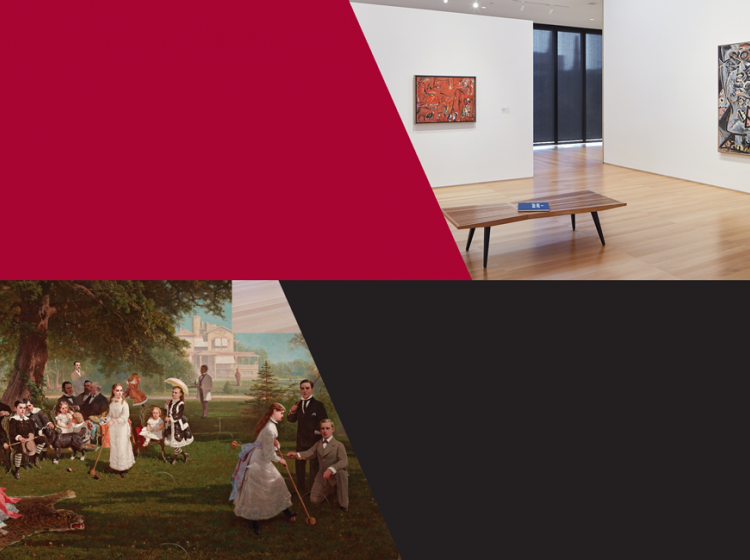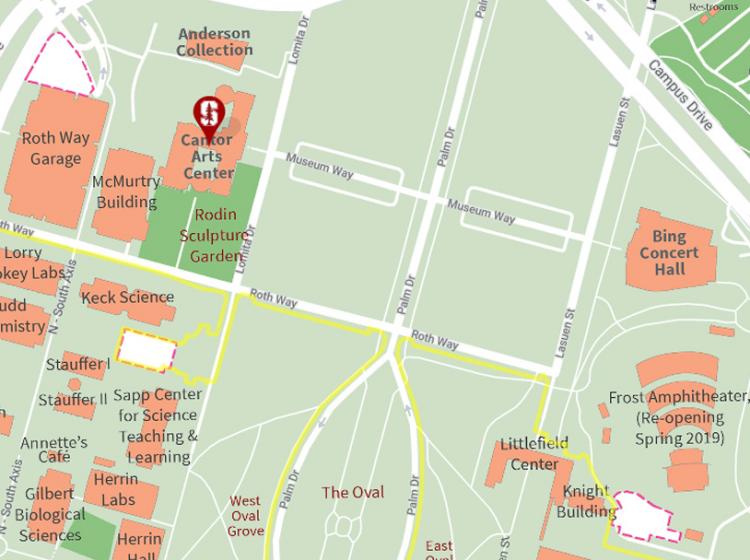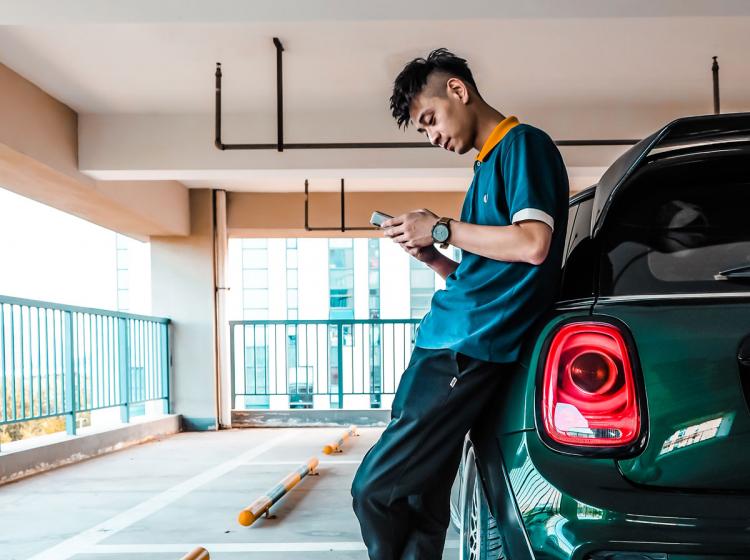Cantor Arts Center
328 Lomita Drive at Museum Way
Stanford, CA 94305-5060
Phone: 650-723-4177

George Matsusaburo Hibi (American, born in Japan, 1886–1947), Three Muses, 1930. Oil on canvas. Cantor Arts Center, Stanford University. The Michael Donald Brown Collection, made possible by the William Alden Campbell and Martha Campbell Art Acquisition Fund and the Asian American Art Initiative Acquisitions Fund, 2020.54
For thousands of years, people have made treacherous journeys across bodies of water. Apart from Indigenous and First Nations peoples, all inhabitants of North America are the product of such transoceanic movement. This exhibition considers the ongoing artistic impact of many peoples’ migration across a particular body of water: the Pacific Ocean. What would it mean to understand the United States as being situated not just west of the Atlantic but east of the Pacific? How would this understanding reorient our perception of American art and its significant participants? The works of art presented date from the mid-nineteenth century through the present day. Organized in chronological sections that highlight key moments of intersection between Asia and the United States, this exhibition features artists who worked between and beyond these worlds.
East of the Pacific: Making Histories of Asian American Art is the largest of three inaugural Asian American Art Initiative (AAAI) exhibitions to open at the Cantor Arts Center. Publicly launched in 2021, the AAAI is dedicated to the study of artists and makers of Asian descent and aims to establish Stanford as a leading academic and curatorial center for the study of Asian American art and history. The AAAI is co-directed by Marci Kwon, assistant professor of Art and Art History, and Aleesa Pitchamarn Alexander, Robert M. and Ruth L. Halperin Associate Curator of Modern and Contemporary Art.
In addition to featuring artists of Asian descent, East of the Pacific pays tribute to those who set the stage for the AAAI. Scholars Gordon H. Chang, Mark Dean Johnson, and Margo Machida laid critical groundwork for the field of Asian American art, with work featured in the landmark study Asian American Art: A History, 1850–1970 (Stanford University Press, 2008). Many of the works on view appeared in the groundbreaking Bay Area exhibitions With New Eyes: Towards an Asian American Art History in the West (San Francisco State University Art Department Gallery, 1995) and Asian/American/Modern: Shifting Currents, 1900–1970 (de Young, 2008). Others are drawn from the 141 objects the Cantor acquired from an unparalleled collection of Asian American art amassed by the collector Michael Donald Brown, and from additional recent gifts from artists, artist estates, and collectors intended to bolster the AAAI. The Cantor recognizes the scholarly contributions and generosity of this community that enables a rethinking of our artistic past toward a reimagining of our cultural future.
East of the Pacific cannot tell a comprehensive story of Asian American art. Due to the current collection strengths and the historical migration patterns from Asia to the United States, the exhibition primarily focuses on artists of East Asian descent. South and Southeast Asian Americans, and artists from the Pacific Islands, are little represented. Future projects and acquisitions aim to address this gap. Nevertheless, the show celebrates that the Cantor now has one of the most extensive collections of Asian American art at any American university art museum. The collection continues to grow strategically and intentionally, acknowledging current limitations while simultaneously addressing them.
Join artists Reagan Louie and Livien Yin in a discussion about their artistic practices and artworks responding to and building on archives of the Chinese diaspora. Works by each artist have been gifted or promised to the Cantor Arts Center in support of the Asian American Art Initiative (AAAI). Yin’s work is on view in the exhibition East of the Pacific: Making Histories of Asian American Art (through Feb. 12, 2023) and Louie’s in At Home/On Stage: Asian American Representation in Photography and Film (through Jan. 15, 2023). Co-director of the AAAI and curator of East of the Pacific, Aleesa Pitchamarn Alexander, PhD, and curator of At Home/On Stage, Maggie Dethloff, PhD, will moderate this virtual discussion. A recording will be made available at a later date.

In the nineteenth century, two significant geopolitical changes impacted the relationship between Japan, China, and the United States. The first was Commodore Matthew Perry’s 1853 expedition to forge a trade agreement with Japan, which led to artists traveling across the Pacific Ocean in both directions, creating a unique period of cultural and artistic exchange. The second was the arrival in the 1850s of the first major wave of Chinese immigrants to the United States to work in the gold mines and on the railroads. Works of art in this section represent the mutual but powerfully imbalanced fascinations between artists working across cultural lines during the late nineteenth and early twentieth centuries.
The early twentieth century saw the rise of many Asian American art associations and societies in San Francisco and Los Angeles. Among the most prominent and ideologically distinct was the interethnic collective East West Art Society (EWAS) of San Francisco. This section highlights Asian American members of the EWAS and features work demonstrating their interest in engaging with forms of image-making that blend various influences.
Established in 1848, San Francisco Chinatown is the oldest in North America and has been a site of artistic exploration and occupation for many. Here, works created across a broad chronological range by Chinatown community members and other artists of Chinese descent showcase a spectrum of Chinatown’s representational possibilities.
Following the attack on Pearl Harbor, on February 19, 1942, President Franklin D. Roosevelt issued Executive Order 9066, which authorized the forced evacuation of more than 120,000 Japanese Americans to isolated detention centers and concentration camps. Most of the historic works in this section were created in the detention centers and camps. The more contemporary works were created by Japanese American artists reflecting upon, and grappling with, the aftereffects of their experiences in the camps.
Works in this section by artists of Asian descent showcase varying approaches to abstraction across the twentieth and early twenty-first centuries. These objects broaden our historical, geographical, and cultural understanding of nonrepresentational modes of making and counter the prevailing art historical narrative that Asian Americans were not significant creators of nonrepresentational art during this time.
In 1976, Carlos Villa put together the expansive exhibition Other Sources: An American Essay as a radical rejoinder to the celebrations surrounding the American bicentennial. Villa, a Filipino American, curated a sprawling selection of work by a diverse array of makers, which he called “Third World artists.” The exhibition was an example of what would later be commonly known as multiculturalism, featuring artists whose primary influences were not the Western artistic canon. This section brings together work by artists originally included in Other Sources.
To enhance the exhibition, the Cantor collaborated with the Institute for Diversity in the Arts with support from the Stanford Arts Incubator pilot program to commission the Asian American artist performance collective For You to create a series of original audio tours. These nondidactic, imaginative audio experiences offer a different mode of engaging with the exhibition. To listen to a tour, please open the link in a separate tab, start the audio, then return to this page to view the accompanying slideshow. If experiencing the tour in person, we highly recommend the use of personal headphones.

The Cantor Arts Center is located at the intersection of Museum Way and Lomita Drive in the heart of the arts district on the Stanford campus. The Cantor faces the Bing Concert Hall across Palm Drive, northwest of The Oval and the Main Quad.

Parking is limited. Stanford has a new contactless process to pay for parking, using the ParkMobile app, website, or phone. Prior to your visit, we recommend you visit the Stanford Transportation website to learn more about the updated visitor parking process.
